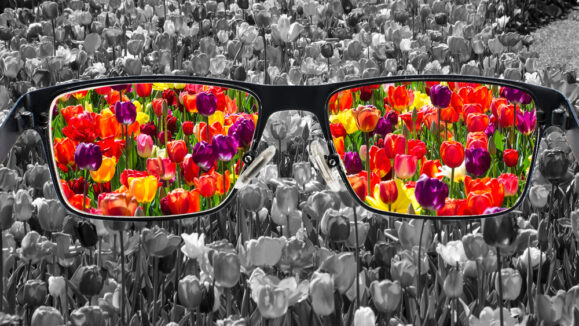It’s easier than ever before to fit contacts for irregular corneas…
Five hundred years ago, Leonardo Da Vinci theorized in the Codex of the Eye that vision could be altered by submerging the head into a bowl of water. More than a century later, René Descartes suggested filling a glass tube with water and placing it directly against the cornea. Obviously, these ideas were not practical for a number of ergonomic reasons.
Since then, we’ve jumped from scleral glass lenses (ouch!), to wax adhesive contacts (possibly, more ouch), and options that deprive eyes of oxygen (which is straight up dangerous). Luckily, the contact lenses of today offer a lot more comfort and variety — from the malleable daily lenses to Ortho-K, and even decorative planos. Yet we still struggle to fashion products that work for patients with atypical eyes.
Not Your Average Cornea
Regular corneal contact lenses naturally do not fit patients with corneal distortion, severe dry eyes, corneal transplants, severe keratoconus, pellucid marginal degeneration (PMD), or those who are post-LASIK. Nor do they provide good correction for patients with any kind of high or irregular astigmatism. This is when we circle back to scleral lenses — a non-glass, much more comfortable version, of course.
Scleral contacts vault over the cornea to rest on the scleral area, stabilizing the lens position. However, when scleral lenses are mismeasured, they tend to decenter, causing discomfort and poor visual acuity to the patient. Moreover, the lens may rub against the corneoscleral junction, an area occupied by stem cells that we certainly don’t want to be messing with. Unfortunately, due to the difficulty of measuring this area, many patients find themselves repeatedly in and out of the doctor’s office to try on poor-fitting lenses.
This is costly and uncomfortable — not only for the patient, but also for the provider. These patients can take up a lot of precious time and resources, and as a result, some optometrists ultimately decide not to treat these patients. A portion of visually challenged people are then left without solutions, and a niche market opportunity is squandered.
The Right Device for The Right Measurements
However, in Singapore, optometrist Dr. Stan Isaacs has embraced this niche market. He has more than 30 years of experience with contact lenses, specializing in orthokeratology or Ortho-K, which uses custom-designed contact lenses to temporarily reshape the cornea and improve vision. Dr. Isaacs is not only the first practitioner in Singapore to offer Ortho-K, but also the first to implement the Pentacam® (OCULUS Optikgeräte GmbH; Wetzlar, Germany), a device that simplifies the specialty lens fitting process with precise corneal and scleral measurements.
According to Dr. Isaacs, he made the decision to use OCULUS devices 10 years ago based on their ability to measure the ocular anterior segment. Although new devices have come out since then, he continues to implement the Pentacam® in his practice for its other unique qualities. “The Pentacam® is the only product that actually measures corneal tissue and doesn’t reflect off the tear film,” Dr. Isaacs explained, adding that this is thanks to the Scheimpflug camera system.
Already a long-time user of the OCULUS Pentacam® HR, Dr. Isaacs added the Pentacam® Corneal Scleral Profile (CSP) report software seven months ago.The CSP Report also measures a diameter of up to 18 mm, a parameter needed for scleral lens fitting.
Before introducing this instrument, they had to rely on manufacturing lenses based on eye moldings, much like a dentist takes moldings of teeth to make retainers. Because that’s a much more complicated process, the ability to obtain measurements from the CSP Report has been a game-changer for Dr. Isaacs.
“As far as large fitting contact lenses are concerned, it makes our job a lot easier,” said Dr. Isaacs. “We can still do trial-and-error fittings and help these individual patients, but it costs practitioners more because you need more refits and things like that. But using the Pentacam®, you probably need — for the really challenging corneas — maybe one or two refits.” He has also sent his Pentacam® HR to Germany to be upgraded with CSP software; and while his new Pentacam® is fitted with the CSP Report, his older Pentacam® HR will be upgraded by OCULUS with the latest capabilities, like an iris camera so that he will be able to run the CSP software.
He shared that he looks forward to how the combination of a high resolution camera will augment the device’s sclera imaging performance further.
But Wait, There’s More
These aren’t the only Pentacam® features that make fitting specialty lenses more efficient for Dr. Isaacs. The Pentacam® with CSP is the first of its kind to offer direct compatibility with WAVE Contact® Lens System software for designing and manufacturing contact lenses. The programs are linked so that users can move images/scans from the Pentacam® into WAVE, make lens adjustments, and place an order directly.
“It’s a unique product that no one else can compete with at present,” concluded Dr. Isaacs. “And it’s a very unique situation where there’s a good synergy between what’s being produced and what the machine is actually measuring.”
With many practices worried about COVID-19 and experiencing economic hardship, it’s not surprising that optometrists may be reluctant to introduce a brand new device into their practice. Yet the majority of difficult cornea patients’ problems can be solved with specialty lenses.
Dr. Isaacs is optimistic that once daily life goes back to normal, word will spread about the Pentacam® with CSP software and its value in eye care. “Once the international meetings open up,” he shared, “you’re going to find a lot of people talking about this new generation of contact lens fittings, large lens fittings, distorted corneas being helped, and patients that really couldn’t be helped before are now being helped much more easily.”




